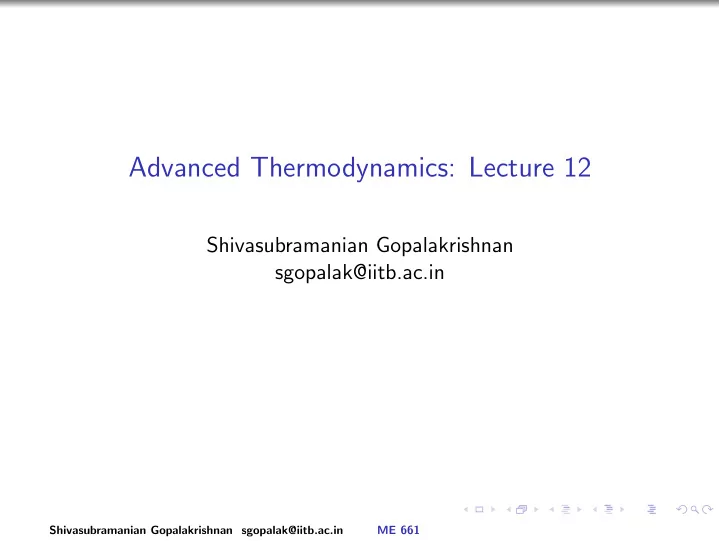

Advanced Thermodynamics: Lecture 12 Shivasubramanian Gopalakrishnan sgopalak@iitb.ac.in Shivasubramanian Gopalakrishnan sgopalak@iitb.ac.in ME 661
Fuel – Any material that can be burned to release thermal energy. Combustion – A chemical reaction during which a fuel is oxidized and a large quantity of energy is released. The oxidizer most often used in combustion processes is air. Reactants – The components that exist before the reaction. Products – The components that exist after the reaction are called products. Shivasubramanian Gopalakrishnan sgopalak@iitb.ac.in ME 661
Fuels Gasoline Equivalence 1 Fuel Energy Content kJ/L L/L – gasoline Gasoline 31,850 1 Light diesel 33,170 0.96 Heavy diesel 35,800 0.89 LPG (Liquefied petroleum 23,410 1.36 gas, primarily propane) Ethanol (or ethyl alcohol) 29,420 1.08 Methanol (or methyl alcohol) 18,210 1.75 CNG (Compressed natural 8,080 3.94 gas, primarily methane, at 200 atm) LNG (Liquefied natural gas, 20,490 1.55 primarily methane) 1 Amount of fuel whose energy content is equal to the energy content of 1-L gasoline. Shivasubramanian Gopalakrishnan sgopalak@iitb.ac.in ME 661
Flash point – The flash point of a volatile material is the lowest temperature at which it can vaporize to form an ignitable mixture in air. Measuring a flash point requires an ignition source. At the flash point, the vapor may cease to burn when the source of ignition is removed. Fire point – The fire point of a fuel is the temperature at which it will continue to burn for at least 5 seconds after ignition by an open flame. Autoignition temperature – The autoignition temperature or kindling point of a substance is the lowest temperature at which it will spontaneously ignite in a normal atmosphere without an external source of ignition, such as a flame or spark. Shivasubramanian Gopalakrishnan sgopalak@iitb.ac.in ME 661
Air–fuel ratio – The ratio of the mass of air to the mass of fuel for a combustion process. Complete combustion – All the combustible components of a fuel are burned to completion during a complete combustion process. Incomplete combustion – The combustion process is incomplete if the combustion products contain any unburned fuel or components. The minimum amount of air needed for the complete combustion of a fuel is called the stoichiometric or theoretical air. Excess air – The amount of air in excess of the stoichiometric amount. Deficiency of air – Amounts of air less than the stoichiometric amount. Shivasubramanian Gopalakrishnan sgopalak@iitb.ac.in ME 661
Balancing the Combustion Equation One kmol of octane ( C 8 H 18 ) is burned with air that contains 20 kmol of O 2 . Assuming the products contain only CO 2 , H 2 O , O 2 , and N 2 , determine the mole number of each gas in the products and the airfuel ratio for this combustion process Shivasubramanian Gopalakrishnan sgopalak@iitb.ac.in ME 661
Enthalpy of reaction – is defined as the di ff erence between the enthalpy of the products at a specified state and the enthalpy of the reactants at the same state for a complete reaction. Exothermic reactions give out heat. Endothermic reactions consume heat. Enthalpy of formation – can be viewed as the enthalpy of a substance at a specified state due to its chemical composition. It is necessary to have a common reference state for all substances. The chosen reference state is 25C (77F) and 1 atm, which is known as the standard reference state. Property values at the standard reference state are indicated by a superscript ( o ) (such as h o and u o ). Shivasubramanian Gopalakrishnan sgopalak@iitb.ac.in ME 661
Heating value of the fuel is defined as the amount of heat released when a fuel is burned completely in a steady-flow process and the products are returned to the state of the reactants. The heating value depends on the phase of the H 2 O in the products. The heating value is called the higher heating value (HHV) when the H 2 O in the products is in the liquid form. It is called the lower heating value (LHV) when the H 2 O in the products is in the vapor form. HHV = LHV + ( mh fg ) h 2 0 Shivasubramanian Gopalakrishnan sgopalak@iitb.ac.in ME 661
Dew-Point Temperature of Combustion Products Ethane ( C 2 H 6 ) is burned with 20 percent excess air during a combustion process. Assuming complete combustion and a total pressure of 100 kPa, determine (a) the air–fuel ratio and (b) the dew-point temperature of the products. Shivasubramanian Gopalakrishnan sgopalak@iitb.ac.in ME 661
Combustion of a Gaseous Fuel with Moist Air A certain natural gas has the following volumetric analysis: 72 percent CH 4 , 9 percent H 2 , 14 percent N 2 , 2 percent O 2 , and 3 percent CO 2 . This gas is now burned with the stoichiometric amount of air that enters the combustion chamber at 20C, 1 atm, and 80 percent relative humidity. Assuming complete combustion and a total pressure of 1 atm, determine the dew-point temperature of the products. Shivasubramanian Gopalakrishnan sgopalak@iitb.ac.in ME 661
Reverse Combustion Analysis Octane (C8H18) is burned with dry air. The volumetric analysis of the products on a dry basis is Species Percent CO 2 10.02 5.62 O 2 CO 0.88 N 2 83.48 Determine (a) the air–fuel ratio, (b) the percentage of theoretical air used, and (c) the amount of H2O that condenses as the products are cooled to 25C at 100 kPa. Shivasubramanian Gopalakrishnan sgopalak@iitb.ac.in ME 661
Evaluation of the Enthalpy of Combustion Determine the enthalpy of combustion of liquid octane ( C 8 H 18 ) at 25C and 1 atm, using enthalpy-of-formation data. Assume the water in the products is in the liquid form. Shivasubramanian Gopalakrishnan sgopalak@iitb.ac.in ME 661
Recommend
More recommend